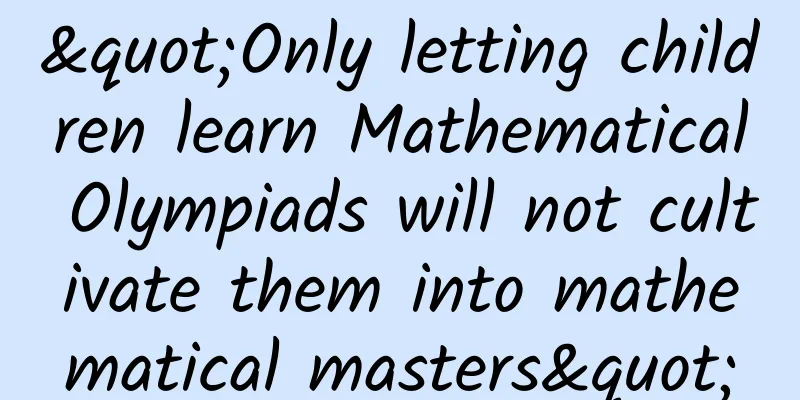Computers are running wild: exponential computing! We still need quantum computing to help

|
Produced by: Science Popularization China Author: Luan Chunyang (Department of Physics, Tsinghua University) Producer: China Science Expo As mentioned in the previous chapter, the further development of "supercomputers" is limited by many problems. So, how can we continue to improve the computing power of computers while reducing their size and power consumption? (Photo source: Veer Gallery) When computers meet "quantum" As the saying goes, when in doubt, turn to quantum mechanics. If computers encounter quantum mechanics, can this imaginative "quantum computer" use the magic of quantum mechanics to handle complex problems that require exponential computing power? We know that classical computers use binary to perform operations, and each basic unit of calculation can only be in a certain state of 0 or 1. This basic unit of calculation is also called a "bit". However, this also means that we can only increase the density of transistors on the chip to increase the number of "bits" of classical computers, thereby linearly improving the data computing power. However, if we use a "quantum computer", this vexing problem can be easily solved. The basic computing unit of a "quantum computer" is called a "quantum bit", which can be in a state of 0 or 1 at the same time with probabilistic accuracy. In other words, a "quantum computer" with N "quantum bits" can be in 2 to the power of N possible states at the same time, and 2 to the power of N will show an exponential growth as N increases, thus having exponentially powerful computing power. Just imagine, if we have such a peculiar "quantum bit", then 1 "quantum bit" can act as 2 computing units, 10 "quantum bits" can act as 1024 computing units, and 100 "quantum bits" can actually act as approximately 1.27 to the power of 30 computing units... In this way, we can use a "quantum computer" with very few "quantum bits" to defeat the magic of computing problems that require exponential orders of magnitude. Schrödinger's Cat——Feel the charm of "quantum superposition" Fortunately, the "quantum superposition" in quantum mechanics provides us with this magical power. As the name suggests, "quantum superposition" means that a quantum system can be in a superposition of multiple states at the same time before being measured. (Photo source: Veer Gallery) For example, let's assume that a cat is sealed in a box that cannot be observed from the outside, and there is a switch in the box that can trigger the release of toxic gas, and the condition for triggering the switch is to receive a signal released by the decay of a radioactive isotope. In this case, the decay of the radioactive isotope will trigger the poison switch and kill the kitten, while if it does not decay, the kitten will survive. However, since radioactive isotope decay is probabilistic (assuming a 50% probability), this means that before the box is opened for observation, the kitten's life or death is also a probabilistic superposition. At this point, we find that there is no deterministic way to describe the state of the kitten, because the occurrence of the two events "the kitten is alive" and "the kitten is dead" depends on whether the radioactive isotope decays. In other words, the kitten theoretically has a 50% probability of still being alive, and a 50% probability of having died. Therefore, the kitten is in a superposition state of "the kitten is alive" and "the kitten is dead", and the probability of both states existing is 50%. This is the famous "Schrödinger's cat" thought experiment. Of course, once the box is opened and observed, the state of the kitten will be uniquely determined as "the kitten is alive" or "the kitten is dead", which means that this "quantum superposition state" in quantum mechanics immediately collapses to a certain state after being observed. The basic computing unit of a quantum computer - quantum bit For classical computers, each "bit" representing a basic computing unit is realized by the switch of a single transistor integrated on the chip. When the transistor is turned on, it can represent the 1 state, and when it is off, it represents the 0 state. Similarly, "quantum computers" also need to find a suitable physical carrier as a "quantum bit" to play the magic of "quantum superposition" in the real world. The difference is that this physical carrier needs to maintain the superposition of the 1 state and the 0 state during the calculation process, and how to find this magical "quantum bit" in the real world has always been the goal that scientists have been pursuing. The hard work paid off, and scientists finally found a physical carrier in nature that can maintain the superposition of the 1 state and the 0 state at the same time. This physical carrier is none other than our old friend who we have known since middle school - charged ions. Charged ions have two important characteristics. The first is that they carry an electric charge. We can capture any number of charged ions through the physical means of "electric field-magnetic field". The second is that according to the theory of quantum mechanics, the energy of charged ions is discrete, that is, the energy within the same charged ion has a sequential level, just like the orbit of a planet. This energy ordering is called the energy level structure. Scientific research has found that in this unique discrete energy level structure, specific two energy levels can be selected to construct "quantum bits". Among them, the higher energy level can represent the 1 state, and the lower energy level can represent the 0 state. In this way, the probabilistic transition between the two energy levels can represent the superposition state of 1 and 0. This encoding with charged ions in nature is called a "quantum bit", and this way of performing quantum computing is called an "ion trap". With the continuous advancement of technology, people have begun to try to use artificial physical systems to encode "quantum bits". Studies have found that when the electronic circuit prepared by the photolithography process is cooled to close to 0.015K, it can show discrete energy levels similar to charged ions, and this artificial two-level physical system is also called a "superconducting quantum bit". The advantage of this "superconducting quantum bit" is that it is compatible with modern integrated circuit technology, so it has attracted widespread attention in the industry. However, it also requires an extremely low temperature environment below 0.015K - a little higher than absolute zero and colder than outer space, which requires a super "refrigerator" to provide an extremely low temperature environment. Moreover, each artificial "superconducting quantum bit" cannot be completely consistent, which puts higher requirements on the precision of calibration and the accuracy of control. In addition, physical systems such as neutral atoms, light quanta, quantum dots and more imaginative topological quantum have also been proposed to be used as "quantum bits". At present, "ion traps" and "superconducting quantum bits" are still regarded by scientists as strong candidates for realizing quantum computing. (Photo source: Veer Gallery) Theory turns into reality - quantum computer is born! Scientists estimate that when N ≥ 50, quantum computers will have a computing power of up to 2 to the 50th power, which will exceed the limits of all classical computers. In other words, in dealing with certain specific computing problems, quantum computers will show "quantum superiority" or "quantum hegemony" over classical computers. In 2019, a 53-qubit processor based on the "superconducting quantum computing" solution suddenly came out. It took only about 200 seconds to complete a sampling task for a specific random number, while this calculation problem would take about 10,000 years even with the most powerful supercomputer at the time. This exponential computing power not only improves the computing speed, but also brings a revolutionary impact to many traditional industries. For example, the public-private key encryption (RSA) algorithm widely used in the modern financial industry is considered to be absolutely safe because even the most powerful supercomputer would take about 80 years to crack the password, while a quantum computer can use its exponential computing power to brute force it in only about 8 hours. This means that modern encryption systems based on traditional cryptography will face a huge impact from quantum computers. (Photo source: Veer Gallery) Quantum simulation: custom-tailored for specific problems It is worth noting that "quantum computers" only demonstrate efficient computing capabilities for certain quantum algorithms and cannot replace classical computers to handle daily office tasks. In addition, the quantum superposition of "quantum bits" themselves is also extremely susceptible to external interference and loss, and there is still a long way to go before quantum computers that can ultimately achieve large-scale fault tolerance can be realized. However, before the ultimate realization of a general-purpose "quantum computer", we can still construct special-purpose machines to handle specific computing problems. At this stage, we generally call this kind of special-purpose quantum computer a "quantum simulator" or simply "quantum simulation." In fact, special machines that can handle specific calculations are not far away from us. The large wind tunnels used in aircraft design are an interesting example. Taking the aerodynamic shape optimization design in aircraft design as an example, the computer simulation in the classical sense needs to grid the aircraft and the nearby airflow, and calculate the force analysis and motion state of each grid, and finally integrate all the calculation grids to obtain the aerodynamic data of the entire aircraft. (Photo source: Veer Gallery) In order to achieve sufficiently small grid accuracy, the computing power of a "supercomputer" is often required to achieve short-term data operations, and further unlimited discrete grid analysis is impossible. In order to solve this calculation problem, a scaled-down model of the aircraft is generally used to conduct wind tunnel simulation experiments directly in a large wind tunnel to intuitively verify the reliability of the aircraft's aerodynamic shape. In fact, the large wind tunnel itself is a computer. As long as we input different aerodynamic parameters, we can intuitively obtain the simulated force and motion state of the aircraft. It’s just that this "wind tunnel computer" is not the computer we imagine, but it performs far beyond the capabilities of classical computers in specific algorithmic tasks of aircraft design. (Photo source: Veer Gallery) This wonderful idea has also driven scientists to re-examine some extremely complex computational problems, such as molecular dynamics simulation of drug reaction processes, relativistic simulation of black hole collisions, and electron escape problems in nuclear fusion processes. In fact, as early as 1982, physicist Richard Feynman proposed: "The computing resources required in quantum mechanics increase exponentially with the increase in the number of particles, and the best way is to use another more controllable quantum system to simulate the original complex quantum system." Simply put, for some computational problems that require exponential computing requirements, we should no longer use the classical calculation method of 0 and 1 to solve them. Instead, we should find another simple and controllable physical system to perform equivalent simulation of the originally complex problem, thereby avoiding the huge waste of computing resources. This is the basic starting point of "quantum simulation." (Photo source: Veer Gallery) (Photo source: Veer Gallery) Therefore, it can be said that "quantum computer" is also a generalized quantum simulation system, but "quantum computer" utilizes the parallel computing characteristics of quantum superposition state, and realizes exponential data computing capabilities through "quantum bits" and a series of quantum logic gate operations. "Quantum simulator" belongs to the narrow sense of quantum simulation system, which can complete the simulation of specific complex quantum systems in a simple and controllable way by constructing a physical model equivalent to the target system. (Photo source: Veer Gallery) Therefore, it can be concluded that "supercomputers" are the resource optimization and integration of classical computers, "quantum computers" utilize a new computing method in quantum mechanics and are a general-purpose computing machine for the future, and "quantum simulation" also utilizes a new computing method in quantum mechanics, but it is a special-purpose computing machine that can simulate specific problems at this stage. However, the emergence of the latter two tells us an exciting fact - the quantum era is quietly approaching, and it will profoundly change people's future production and lifestyle in an unprecedented way. This change is unimaginable, just as when people in the 19th century used mechanical calculating machines such as abacus, they could not imagine that the computing power contained in electronic computers would completely subvert the way of information exchange. Let’s imagine the future. With the powerful exponential computing power of quantum computers, what earth-shaking changes will our world undergo? Editor: Sun Chenyu |
Recommend
The "calcium" gang in the nutrition world cannot do without this "military advisor"
Author: Cui Yihui, registered dietitian, master o...
This is how products with over 100 million users retain users
The content of this article is a summary after ac...
Space telescopes: a different way of imaging
Not long ago, NASA officially released the first ...
Lu Feifei_Fei Chang Memory Super Brain Training Camp 34th
Lu Feifei·Fei Chang Memory Super Brain Training C...
How to operate a Douyin corporate account without experience and manpower?
With the rise of short video platforms, more and ...
4 tips to help you get a good night's sleep, use them before going to bed tonight!
In the new year, while everyone is working hard, ...
The fourth round of 51CTO developer community administrator recruitment has been successfully completed
[51CTO.com original article] Thank you very much ...
APP promotion: the details of Xiaomi promotion that you don’t know!
After Xiaomi became famous, the term "Weibo ...
Anyone who buys an iPhone 6 now should be despised
Since the iPhone 6 was launched on the 19th, it h...
Welfare! About new media, copywriting and industry report downloads!
The operation uncle recently launched a Will be c...
Digital RMB App released version 1.0.4 update, consumption red envelope balance can be displayed independently
On January 26, the Digital RMB (pilot version) Ap...
10-year-old boy is nearly blind! Doctors remind: Don’t use eye drops randomly, especially these types…
Staring at mobile phones or computers for a long ...
Kang Ge: Build a small money-making machine in 30 days
Kang Ge's resource introduction of "Build...
With a valuation of $3.7 billion, it may dominate the future development of VR/AR hardware!
There is no doubt that virtual reality/augmented ...









